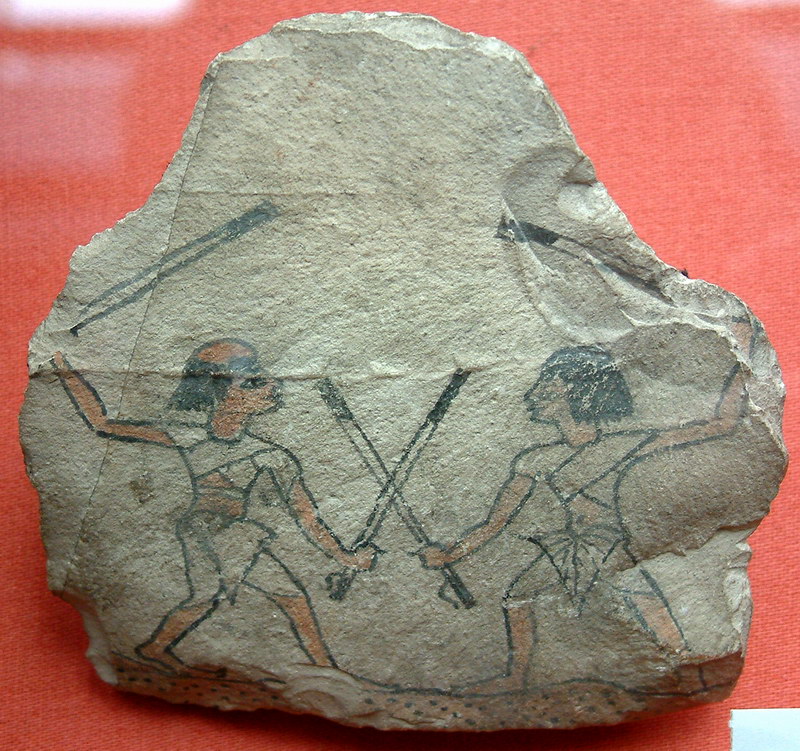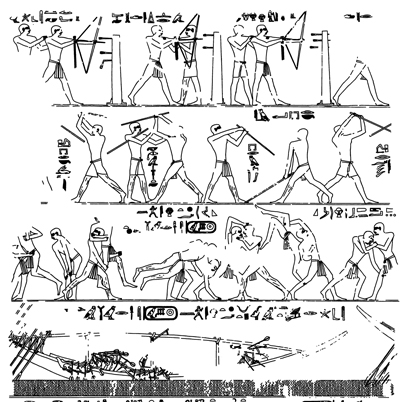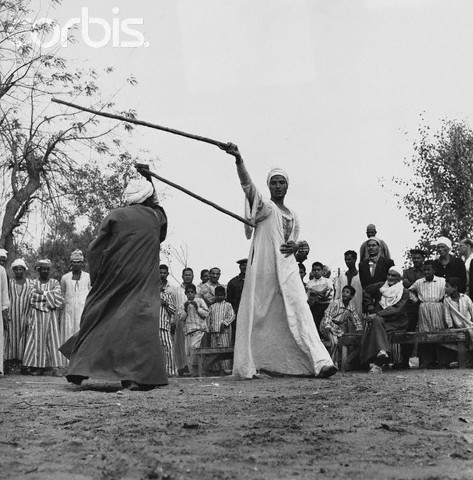Tahtib on:
[Wikipedia]
[Google]
[Amazon]
 Tahtib ( arz, تحطيب, taḥṭīb) is the term for a traditional stick-fighting
Tahtib ( arz, تحطيب, taḥṭīb) is the term for a traditional stick-fighting
 The oldest traces of tahtib were found on engravings from the archaeological site of
The oldest traces of tahtib were found on engravings from the archaeological site of  Three of the 35 tombs of the
Three of the 35 tombs of the
Beni Hasan (with plates) by Percy Newberry, et al.Beni Hasan - Archaeowiki.orgN. de G. Davies's "Rock Tombs of El Amarna", in openlibrary.org
{{Martial arts Stick-fighting African martial arts Asian martial arts Sport in Egypt Sports originating in Egypt Egyptian dances Egyptian culture
 Tahtib ( arz, تحطيب, taḥṭīb) is the term for a traditional stick-fighting
Tahtib ( arz, تحطيب, taḥṭīb) is the term for a traditional stick-fighting martial art
Martial arts are codified systems and traditions of combat practiced for a number of reasons such as self-defense; military and law enforcement applications; competition; physical, mental, and spiritual development; entertainment; and the preserv ...
originally named ''fan a'nazaha wa-tahtib'' ("the art of being straight and honest through the use of stick"). The original martial version of tahtib later evolved into an Egyptian folk dance with a wooden stick. It is commonly described in English
English usually refers to:
* English language
* English people
English may also refer to:
Peoples, culture, and language
* ''English'', an adjective for something of, from, or related to England
** English national ide ...
as a "stick dance", "cane dance", "stick-dancing game", or as ritual mock combat
Mock combat involves the execution of combative actions without intent to harm. Participants can engage in such sparring for ritual, training, recreational or performance reasons. The nature of mock combat can vary from realistic to symbolic.
M ...
accompanied by music. Nowadays, the word ''tahtib'' encompasses both martial practice and performance art. It is mainly practiced today in Upper Egypt
Upper Egypt ( ar, صعيد مصر ', shortened to , , locally: ; ) is the southern portion of Egypt and is composed of the lands on both sides of the Nile that extend upriver from Lower Egypt in the north to Nubia in the south.
In ancient ...
. Tahtib is regularly performed for tourists in Luxor
Luxor ( ar, الأقصر, al-ʾuqṣur, lit=the palaces) is a modern city in Upper (southern) Egypt which includes the site of the Ancient Egyptian city of ''Thebes''.
Luxor has frequently been characterized as the "world's greatest open-a ...
and Aswan
Aswan (, also ; ar, أسوان, ʾAswān ; cop, Ⲥⲟⲩⲁⲛ ) is a city in Southern Egypt, and is the capital of the Aswan Governorate.
Aswan is a busy market and tourist centre located just north of the Aswan Dam on the east bank of the ...
.
The stick used in tahtib is about four feet in length and is called an ''asa'', ''asaya'', ''assaya'', or ''nabboot''. It is often flailed in large figure-eight patterns across the body with such speed that the displacement of air is loudly discernible.
History
 The oldest traces of tahtib were found on engravings from the archaeological site of
The oldest traces of tahtib were found on engravings from the archaeological site of Abusir
Abusir ( ar, ابو صير ; Egyptian ''pr wsjr'' cop, ⲃⲟⲩⲥⲓⲣⲓ ' "the House or Temple of Osiris"; grc, Βούσιρις) is the name given to an Egyptian archaeological locality – specifically, an extensive necropolis of ...
, an extensive necropolis of the Old Kingdom
In ancient Egyptian history, the Old Kingdom is the period spanning c. 2700–2200 BC. It is also known as the "Age of the Pyramids" or the "Age of the Pyramid Builders", as it encompasses the reigns of the great pyramid-builders of the Fourth ...
period, located in the south-western suburbs of Cairo
Cairo ( ; ar, القاهرة, al-Qāhirah, ) is the capital of Egypt and its largest city, home to 10 million people. It is also part of the largest urban agglomeration in Africa, the Arab world and the Middle East: The Greater Cairo metro ...
. On some of the reliefs of the Pyramid of Sahure (V dynasty, c. 2500 BC); the images and explanatory captions are particularly precise and accurate in their depiction of what seems to be military training using sticks. Tahtib, with archery and wrestling, was then among the three disciplines of warfare taught to soldiers.
 Three of the 35 tombs of the
Three of the 35 tombs of the Beni Hassan
is a Japanese R&B singer, who debuted in 2004 under the Avex Trax label. In 2008, Arashiro left Avex Trax and transferred to Universal Music Japan where she started to perform as simply Beni (stylized as BENI).
She was initially best known fo ...
necropolis (XI-XII Dynasties, 1900 – 1700 BC) near the town of Minya, contain engravings showing scenes of tahtib. Similar engravings can be seen in the archaeological site of Tell el Amarna (XVIII Dynasty, 1350 BC), some 60 km south of Minya. In addition to its role as military training, tahtib matches were also popular among peasants and farmers. The first evidence of the festive representation of tahtib can only be seen in the New Empire (1500 – 1000 BC), as shown by the engravings on the walls of Luxor
Luxor ( ar, الأقصر, al-ʾuqṣur, lit=the palaces) is a modern city in Upper (southern) Egypt which includes the site of the Ancient Egyptian city of ''Thebes''.
Luxor has frequently been characterized as the "world's greatest open-a ...
and Saqqâra Early Christian writings mention tahtib as a leisure activity and a popular art performed by men during weddings and celebrations. It is believed that tahtib developed as a game or performance art in this civilian context.
Performance
As with its combative counterpart, the dance form of tahtib was originally performed by men, but female versions were later developed. In one form, the women dress as men and imitate the males. Another female variant is performed flirtatiously and with less aggression. The latter, called ''ra's el assaya'' (dance of the stick) is incorporated into cabaret or Raqs sharqi performances. The stick used for this dance is generally more lightweight and hooked at one end like a cane. It is often embellished with metallic-coloured foil or sequins. The costume is a simplebaladi
Baladi ( ar, بلدي ' relative-adjective 'of town', 'local', 'rural', comparable to English ''folk'', with a lower-class connotation) can refer to an Egyptian musical style, the folk style of Egyptian bellydance (Raqs Baladi), or the Masmoud ...
dress. Performances include balancing the cane on the head, hip or shoulder.
Music
Music in tahtib features the ''tabl'' (bass drum) and mizmar (folk oboe). The right hand uses a heavier stick with a hooked head to beat out the ''dum'' (the deep sound from striking the center of the drum) which drive the heartbeat of the rhythm, while the left hand uses a light twig as a switch to produce rapid-fire staccato "taks" (the higher sound from striking the edge of the drum).Modern tahtib
Modern tahtib is an attempt to re-explore the sources of tahtib as a fighting art, and to enrich them as a martial practice by codifying the techniques and teaching them structurally. As in traditional tahtib, the main target is the opponent's head, as it is considered the most fragile and vulnerable part of the body. Consequently, techniques revolve around protecting one's own head while reaching the head of the opponent. Victory can be attained either by a single clean touch to the head, or three touches to the body. Unlike its traditional counterpart, modern tahtib allows both women and men to practice in mixed groups.See also
* Angampora * Banshay *Bataireacht
In Irish martial arts, (; meaning 'stick-fighting') (also called ''boiscín'' and ''ag imirt na maidí'' ) refers to the various forms of stick-fighting from Ireland.
Definition
''Bataireacht'' is a category of stick-fighting martial arts ...
*Bōjutsu
, translated from Japanese as "staff technique", is the martial art of stick fighting using a bō, which is the Japanese word for staff. Staffs have been in use for thousands of years in Asian martial arts like Silambam. Some techniques involve s ...
*Gatka
Gatka (; ; hi, गतका; ur, ) is a form of martial art associated primarily with the Sikhs of the Punjab and other related ethnic groups, such as Hindkowans. It is a style of stick-fighting, with wooden sticks intended to simulate ...
* Jūkendō
*Kalaripayattu
Kalaripayattu (; also known simply as Kalari) is an Indian martial art that originated in modern-day Kerala, a state on the southwestern coast of India. Kalaripayattu is known for its long-standing history within Indian martial arts, and is ...
*Kendo
is a modern Japanese martial art, descended from kenjutsu (one of the old Japanese martial arts, swordsmanship), that uses bamboo swords (shinai) as well as protective armor (bōgu). Today, it is widely practiced within Japan and has spread ...
*Kenjutsu
is an umbrella term for all ('' ko-budō'') schools of Japanese swordsmanship, in particular those that predate the Meiji Restoration. Some modern styles of kendo and iaido that were established in the 20th century also included modern forms of ...
*Krabi–krabong
Krabi-Krabong ( th, กระบี่กระบอง, ) is a weapon-based martial art from Thailand. It is closely related to other Southeast Asian fighting styles such as Pencak Silat Indonesia, Burmese banshay and Cambodian kbach kun boran ...
*Kuttu Varisai
Silambam is an Indian martial art originating in South India in the Indian subcontinent. This style is mentioned in Tamil Sangam literature. The World Silambam Association is the official international body of Silambam.
Origin
References in ...
*Mardani khel
Mardani khel is an armed Indian martial art from Maharashtra. It is particularly known for its use of the uniquely Indian pata (sword), patta (sword) and ''vita'' (corded lance). The early history of mardani khel as a distinct system is difficult t ...
*Silambam
Silambam is an Indian martial art originating in South India in the Indian subcontinent. This style is mentioned in Tamil Sangam literature. The World Silambam Association is the official international body of Silambam.
Origin
References in ...
* Silambam Asia
*Stick dance (African-American)
Stick dance was a dance style that African–Americans developed on American plantations during the slavery era, where dancing was used to practice "military drills" among the slaves, where the stick used in the dance was in fact a disguised wea ...
*Thang-ta
Huyen langlon is an Indian martial art from Manipur. In the Meitei language, means war while or can mean net, knowledge or art. consists of two main components: thang-ta (armed combat) and sarit sarak (unarmed fighting). The primary weapons ...
*Varma kalai
Varma Kalai (Tamil: ''varmakkalai'', Malayalam and Sanskrit: ''marma-vidya'', Sinhala: ''maru kalā'', Telugu: ''marma-vidya kaḷa'') is a Tamil traditional art of vital points. It originated in present-day Kanyakumari,Tamilnadu, the southern ...
*World Silambam Association
The World Silambam Association (WSA) ( ta, உலக சிலம்பம் சங்கம்) is the official international body of Silambam for Worldwide and a recognized Non-Governmental Organization. On November 22, 1999, the primary name ...
References
Further reading
Beni Hasan (with plates) by Percy Newberry, et al.
{{Martial arts Stick-fighting African martial arts Asian martial arts Sport in Egypt Sports originating in Egypt Egyptian dances Egyptian culture